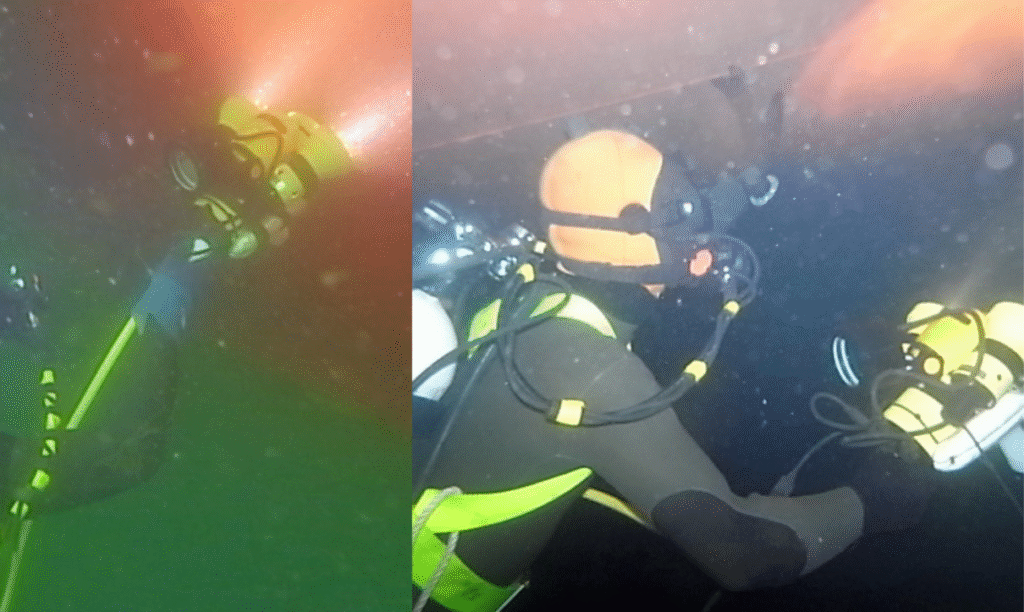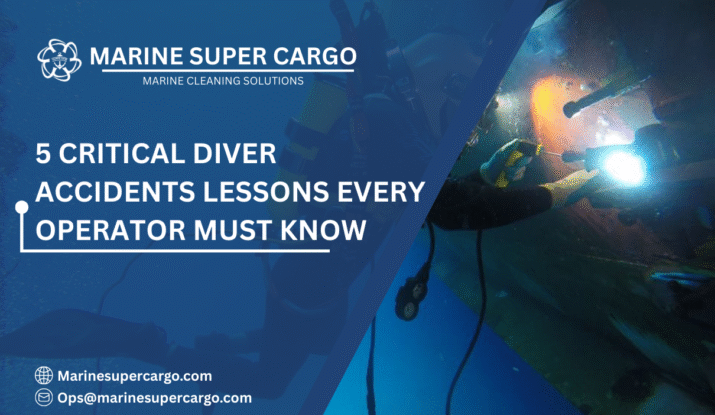When divers go beneath the surface, they face one of the most unforgiving workplaces on Earth. It’s a world of cold silence, immense pressure, and invisible dangers. While diving enables vital underwater tasks—like hull cleaning, inspections, and repairs—mistakes, oversights, or equipment failures can lead to tragedy.
That is why learning from accidents is so essential. Every incident tells a story. Each story holds lessons. And these diver accidents lessons are not just for safety managers—they’re for shipowners, operators, and anyone responsible for marine operations.
In this article, we’ll explore real-world examples, analyze the root causes, and, most importantly, share actionable solutions. Think of this as a deep dive into the past to shape safer practices for the future.
Why Diver Safety is Mission-Critical
Diving is a high-risk job. Unlike working on deck, there’s no margin for error—because emergency exits don’t exist underwater.
Consider the risks:
- Physical hazards: entanglement, falling objects, propeller strikes.
- Physiological hazards: decompression sickness, hypothermia, and nitrogen narcosis.
- Environmental hazards: poor visibility, currents, and marine life.
- Equipment hazards: hose failures, regulator malfunctions, or faulty helmets.
Even with the best training, divers operate at the boundary between human capability and technical dependence. That’s why learning from mistakes is so vital.
Real-World Case Study: Entanglement Incident
In one incident documented by the International Marine Contractors Association (IMCA), a commercial diver became entangled while inspecting a ship’s stern. His umbilical—a lifeline that provides air, communication, and power—wrapped tightly around the propeller guard.
- What went wrong: The diver’s movements weren’t being tracked closely, and the surface team did not notice early warning signs.
- Consequences: The diver lost valuable time trying to free himself, risking hypoxia (low oxygen).
- Lesson: Maintain constant umbilical management and ensure surface personnel are trained to spot patterns of entanglement risk.
It seems simple, but this lesson has saved countless divers since.

The Psychology of Diving Accidents
Accidents don’t just happen because of technical failures—human psychology plays a major role. Divers may:
- Underestimate risks due to routine familiarity.
- Rush through checklists under operational pressure.
- Experience “task fixation,” focusing so much on one task that they ignore their surroundings.
Just like drivers who miss red lights when distracted, divers can unknowingly put themselves in danger. These psychological factors highlight critical Diver Accidents Lessons that cannot be ignored. By understanding Diver Accidents Lessons, supervisors and crews can build stronger safety cultures. Ultimately, embedding these Diver Accidents Lessons into training ensures safer, more resilient diving operations.
Common Diver Accidents: Lessons We Must Learn
Here are the seven most critical lessons distilled from past accidents:
- Pre-dive checks save lives
Skipping equipment inspections is a recipe for disaster. Even small leaks or worn seals can become fatal underwater. - Umbilical management prevents entanglement
Proper line tending and real-time monitoring are critical. - Communication is non-negotiable
Divers must maintain clear, working communication with supervisors at all times. Faulty systems or misinterpretations can escalate risks. - Emergency drills build muscle memory
Crews must prepare for bailout procedures, lost diver scenarios, and rapid retrieval. - Environmental awareness is crucial
Strong currents, low visibility, and unexpected marine life must be factored into every dive plan. - Rest and health matter
Fatigue, illness, or dehydration dramatically increases accident likelihood. - Lessons must be recorded and shared
Too often, mistakes are logged but never revisited. Establishing a learning culture ensures future operations benefit from past incidents. Read more
Regulatory Drivers Behind Diver Safety
Maritime regulations and industry standards demand higher safety protocols for diving operations.
- IMCA guidelines: Set international standards for safe commercial diving procedures.
- IMO conventions: Indirectly enforce safety through compliance requirements on vessel operations.
- National authority standards: Many regions impose strict diver certification and equipment checks.
Ignoring diver accidents lessons also risks non-compliance—leading to penalties, failed audits, and reputation damage. Also read about Underwater Hull Cleaning in Cochin.
The High Costs of Ignoring Lessons
Financial consequences rival the human risks:
- Accident investigations delay operations and damage reputations.
- Insurance premiums rise after reportable incidents.
- Legal liabilities emerge when negligence is proved.
- Downtime costs from halted diving operations quickly accumulate.
It’s not dramatic to say that ignoring diver safety costs far more than investing in preventive measures.
Practical Steps to Apply Lessons
If you’re a ship manager or operator, you can turn knowledge into practice by:
- Developing detailed dive plans for each job.
- Ensuring qualified supervisors are present for every dive.
- Scheduling frequent training and refresher drills for divers and surface teams.
- Using real-time monitoring systems to enhance diver tracking.
- Keeping an incident database for ongoing learning and prevention.
Safety is not just a checklist—it’s a culture.
Technology’s Role in Reducing Diver Risks
The future of diving safety is shaped by innovation:
- ROVs and hull-cleaning robots: Reduce the number of manned dives required.
- Wireless communication systems: Provide dual redundancy in case of primary comms failure.
- Digital twin simulations: Allow teams to rehearse complex dives in virtual environments.
- AI-driven analysis: Spot accident risk factors from dive logs and operational data.
These innovations reduce exposure and reinforce the lessons already learned.
✅ 4 Things to Check for Safety at Sea pic.twitter.com/dAxhJQ2i6U
— Marine Super Cargo (@Marinsupercargo) September 14, 2025
Building a Culture of Safety
The single biggest takeaway from diver accidents lessons is that safety doesn’t live in a manual—it lives in people’s attitudes. Just as ships rely on crews working in harmony, diving operations demand a “culture of care”:
- Speak up when unsafe conditions are noticed.
- Encourage reporting without blame.
- Share open lessons across teams and fleets.
This cultural shift can be the greatest life-saving tool of all.

Future Outlook
The future of diver safety will involve:
- Increased reliance on unmanned robotic systems.
- Enhanced environmental monitoring to predict and manage underwater risks.
- Closer integration of safety management systems (SMS) with diving operations.
- Wider collaboration between shipping, port authorities, and contractors to enforce compliance.
Ultimately, Diver Accidents Lessons are driving innovation by highlighting weak points that technology and training must address. These Diver Accidents Lessons ensure the industry moves toward a future where diving is safer, smarter, and more sustainable.
Conclusion
From entanglements to equipment failures, psychology to planning, the lessons are clear:
- Every accident points to preventable issues.
- Compliance, culture, and training are the keys to prevention.
- Technology is a supporting pillar, but discipline in human processes remains vital.
By applying these diver accidents lessons, you not only save lives—you protect operations and preserve trust. To ensure your diving operations are aligned with modern safety expectations, explore the resources at CleanShip.co and take action before accidents occur.
FAQs:
Q1. What are the main causes of diving accidents?
Understanding Diver Accidents Lessons begins with identifying causes such as poor planning, equipment failure, entanglement, communication breakdowns, and human fatigue.
Q2. How can divers avoid entanglement accidents?
One of the most valuable Diver Accidents Lessons is the importance of effective umbilical management, real-time tracking, and situational awareness to reduce entanglement risks.
Q3. Why is diver communication so important?
Clear communication is central to Diver Accidents Lessons, ensuring supervisors can monitor conditions, warn of hazards, and coordinate rapid rescue during emergencies.
Q4. What role do regulations play in preventing accidents?
Regulations from IMCA and IMO highlight Diver Accidents Lessons by enforcing global safety standards, making compliance critical for all professional diving operations.
Q5. Can technology fully replace human divers?
Not yet. While ROVs and robots take over routine inspections, complex repair and emergency response still rely on skilled divers.


